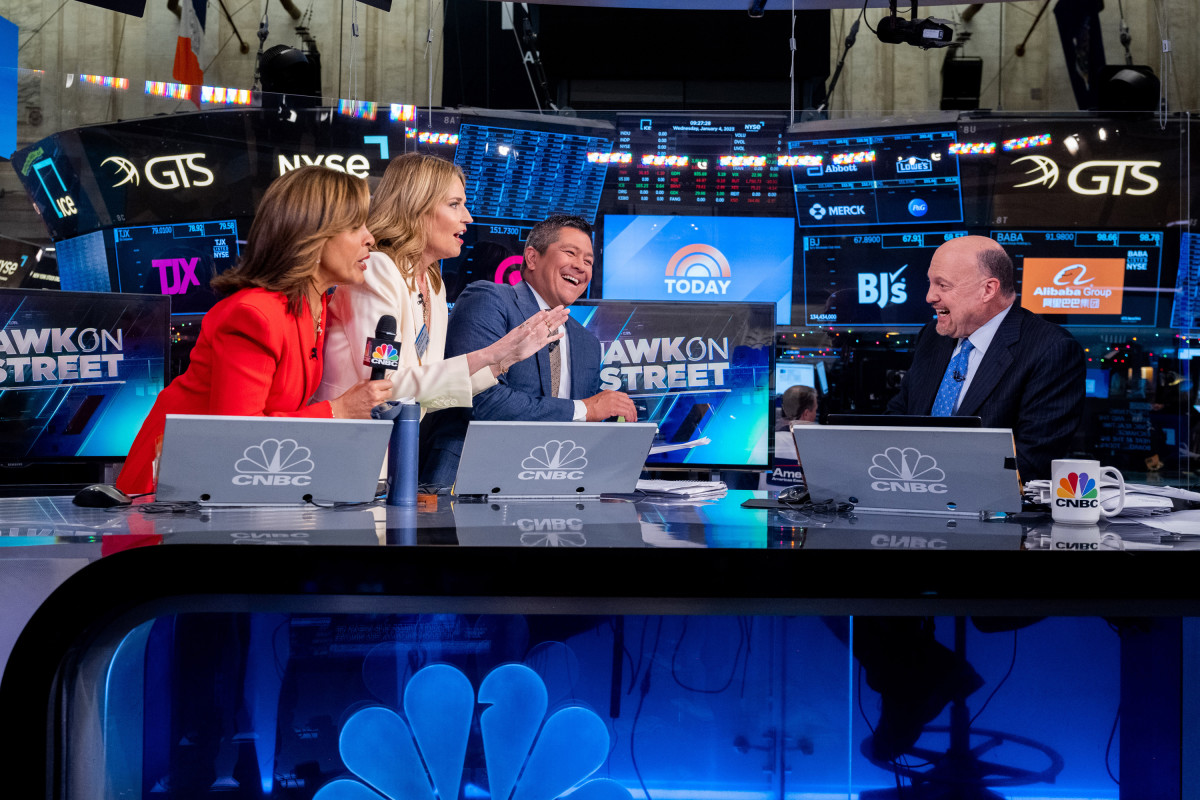
Jim Cramer (who cofounded this publication in 1996 but left in 2021) is a well-known investing personality and former hedge fund manager. He got his start on Wall Street working as an investment banker with Goldman Sachs in the mid-80s. These days, he haunts the floor of the New York Stock Exchange each trading day on CNBC’s “Squawk on the Street,” a news program that follows the first 90 minutes of each day’s trading session.
On “Mad Money,” Cramer’s daily evening show, the boisterous investor sports rolled-up sleeves, talks a mile a minute and makes frequent use of a radio-DJ-style soundboard of big-red-button-activated sound effects. He does all of this while doling out his latest takes on the market — all on just four hours of sleep per night, according to a 2015 interview with “Business Insider.”
Related: Cathie Wood net worth: Why the Ark Invest CEO is an investor to watch
Whether you love him, hate him, or simply enjoy watching his eccentric antics bemusedly from a distance, you have to admit that Jim Cramer is one of the loudest voices on Wall Street, and his advice does cause stock prices to move — at least temporarily.
That being said, many of his stock picks have flopped shortly after he recommended them. His predictions have been wrong too many times to count. A 2017 study by the Wharton School that analyzed Cramer's Action Alerts Plus portfolio from 2000 to 2017 determined that it returned an average of 4.08% annually. Compared to the S&P 500's average annual return of 7.07% over that same period, his recs come up short.
#Bitcoin up +38% since Jim Cramer said "Bitcoin is about to go down big!”
— Bitcoin Archive (@BTC_Archive) November 27, 2023
Never fails... 😅 pic.twitter.com/uLB9eo7O8F
Many investors — especially the non-traditional ones that hang out in Reddit forums like r/WallStreetBets — aren’t impressed by his advice. They get a kick out of jokingly advising blindly doing the opposite of whatever Cramer suggests.
Well, as of March 2023, that can be done with a single click by purchasing shares of the Inverse Cramer Tracker ETF by Tuttle Capital Management.
What is the Inverse Cramer Tracker ETF (SJIM)?
The Inverse Cramer Tracker ETF (SJIM) -) is an exchange-traded fund created by Tuttle Capital Management with the purpose of making trades contrary to Jim Cramer’s financial advice. According to the fund’s prospectus, it “seeks to provide investment results that are approximately the opposite of, before fees and expenses, the results of the investments recommended by television personality Jim Cramer.”
Like all actively managed ETFs, the inverse Cramer Tracker is a professionally curated collection of multiple securities packaged together into a single, convenient security. It trades publicly on an exchange just like a stock. With a single purchase of SJIM, an investor gains exposure to a suite of positions assembled by Tuttle Capital Management to approximate the opposite of what Jim Cramer recommends doing.
If Cramer says it’s time to sell Tesla, for instance, SJIM buys it. If Cramer’s advice is to buy Nvidia, the fund shorts it — at least that’s the general idea.
Related: The wisdom of Charlie Munger: 5 simple steps to investment success
How does the inverse Cramer fund work?
SJIM attempts to meet its objective first by actively monitoring the analyses made by Cramer on three different platforms: his morning show “Squawk on the Street,” his evening show “Mad Money,” and his X (formerly Twitter) feed. The Inverse Cramer fund then buys, shorts, or sells the mentioned stocks or funds in real-time in a direction contrary to Cramer’s recommendations.
According to SJIM’s prospectus, “Should Cramer recommend buying any of the securities in the Fund’s portfolio, the Fund will dispose of those holdings. Should Cramer recommend selling any of the securities in the Fund’s portfolio, the Fund will keep those holdings.”
The prospectus goes on to explain what the fund’s manager might do in certain unique circumstances: “The adviser may also sell securities that have gone ‘stale’ — i.e., have been held for several weeks with no further commentary by Cramer. If Cramer does not take any view on any of the securities in the Fund’s portfolio, including when he is absent from CNBC or Twitter for any reason, the adviser further retains discretion to sell positions if market conditions … necessitate a sale … and replace them with securities that represent the opposite side of Cramer’s previously announced market or sector view.”
The prospectus also states that the fund does not typically hold any position longer than a five-day trading week, except in situations where Cramer continues to mention a stock on a regular basis.
View the original article to see embedded media.
What are inverse ETFs and why is the Inverse Cramer unique?
Inverse ETFs are not a new phenomenon. Many exist, and most are focused on producing returns that inversely mirror a target stock index or market sector. The popular ProShares Short Russell2000 ETF, for instance, aims to produce returns opposite those of the Russel 2000 index, which tracks the small-cap portion of the American stock market. If an investor was bearish on small-cap stocks, for instance, they could buy shares of the Short Russel2000 fund, and their shares would increase in value if the Russel 2000 (an index designed to stack the small-cap sector of the market) fell.
What makes the Inverse Cramer ETF unique among inverse ETFs in general is that it is one of very few whose benchmark is not a fund, index, or market sector (e.g., small-caps or industrial stocks). Rather than betting against the market or some portion of it, the Inverse Cramer ETF bets against the recommendations of a single financial pundit.
Interestingly, Cramer doesn’t manage an actual fund based on his televised advice, and he doesn’t even necessarily own the stocks he touts personally. He simply analyzes the market and trending stocks and makes recommendations to his viewers based on his analyses. This means that when someone buys the inverse Cramer ETF, they are not betting against a real fund, index, or portfolio — they are betting against a hypothetical portfolio comprising positions that Cramer endorses on his shows and social media feeds.

What was the Long Cramer Tracker ETF (LJIM)? Why was it delisted?
When Tuttle Capital Management first launched the Inverse Cramer Tracker ETF in March 2023, they also launched its counterpart — the Long Cramer Tracker ETF, which followed Cramer’s televised and social media trading advice to a tee. In other words, LJIM was the opposite of SJIM — it was designed to be bullish on Cramer’s stock picks, but it was far less popular, and it didn’t last long.
According to Matthew Tuttle, CEO of Tuttle Capital Management, the two funds were created in part to “facilitate a conversation with Jim Cramer around his stock picks.” He went on to say that, “unfortunately, Mr. Cramer and CNBC have been unwilling to engage in dialogue and instead have chosen to ignore the funds, therefore there is no reason to keep the long side going.”
Tuttle’s admonishment aside, LJIM only picked up around $1.3 million worth of assets under management by the time it shuttered in September 2023 compared to SJIM’s $3.2 million over the same period. Clearly, the hyper-focused ETFs made more of a splash with Cramer bears than Cramer bulls, and the Long Cramer Tracker was most likely canned due to a lack of interest, and thus, funds.
What are the fees associated with SJIM and how is it weighted?
Like most ETFs, SJIM carries an expense ratio, which is a fee charged to each investor annually as a percentage of their investment. Passively managed ETFs, like index funds, tend to carry lower expense ratios because their management does not require much effort. Actively managed ETFs, like the Inverse Cramer Tracker, tend to have higher expense ratios because their managers must watch the market and actively open and close positions.
SJIM charges a 1.2% expense ratio, which is very high, even for an actively managed fund. For comparison, the JPMorgan Equity Premium Income ETF, which was the most popular actively managed ETF in 2023, charged only 0.35%.
SJIM’s weighting is also important to consider. The fund’s positions are meant to be equally weighted, meaning each position held by the fund has the same influence on the fund’s overall performance as each other position. In other words, if, on an episode of “Mad Money” Cramer says he is slightly bearish on P&G and extremely bearish on Kraft Heinz Co., the ETF would purchase equal amounts of each stock rather than weighing its positions based on just how poorly Cramer expects each stock to perform in the near future.
Is SJIM a good investment? What traders need to know
The Inverse Cramer Tracker ETF hasn’t been around for long, so it’s difficult to meaningfully examine its track record. That said, from its initial listing on Mar. 3, 2023, through Nov. 29, 2023, it returned -12.15%. For comparison, the S&P 500 index returned 12.5%. In other words, the Inverse Cramer Tracker has underperformed the market significantly since its inception.
That being said, this particular ETF isn’t designed to be bought and held — it is likely intended to be used as a shorter-term trading instrument. The fund’s management is quite active, buying, selling, and shorting various stocks on a daily basis contrary to Cramer’s recommendations, and rarely holding a position for more than a week, as mentioned above. Therefore, its long-term performance isn’t a very good indication of whether or not it is useful as a trading vehicle.
Traders who keep an eye on Cramer and wish to bet against his analyses over a holding period of a day or two could certainly see success with the Inverse Cramer ETF if Jim’s predictions turn out to flop, as they sometimes do.
Buy-and-hold investors should probably avoid SJIM, as it does not carry positions for long enough to see them appreciate. Its fees are also high compared to passive index funds, which would likely produce much better returns over the long term.
Simplify investing. Get expert picks now. Subscribe to TheStreet | Smarts today.







